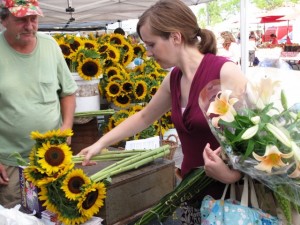
Field-grown peonies should be selected at the “marshmallow” stage, when the heads have just a little give when squeezed.
Forget flowers grown far from home. You’ll find the best blooms right in your own neighborhood – straight from a local flower farmer.
The growth of local farmers’ markets is staggering – up 17 percent nationwide in 2011, according to the USDA (USDA Farmers’ Market Data). And as more farmers’ markets establish in communities across the U.S., you can be certain to find more beautiful flower stalls, which is great news for the DIY floral designer, hostess and nature- lover.
When you shop at a weekly farmers’ market, look for fresh, seasonal and uncommon floral crops – you’ll be wowed by the selection and quality. Yes, it’s fun to meet the people who grow these blooms. But you can also learn from their experience and knowledge — ask your flower farmer for tips on how to care for their beautiful stems at home. Here are some of the best ways to enjoy farmers’ market flowers and extend their vase life:
Selection: Most farmers harvest their crops as close to market day as possible, ensuring very fresh varieties – straight from the field. Shop early in the morning for the best choice (plus, flowers are always happier when it’s cooler!). If the market is in an uncovered location, expect to see large awnings or umbrellas to keep the floral products out of direct sun. Look at the stall’s hygiene – are the buckets clean and filled with fresh water? Be sure to ask “Where is your farm?” and “Why type of growing practices do you use?” – let the vendor know you appreciate sustainable practices.
What to look for:
-

Chicago floral designer Lynn Fosbender, owner of Pollen Flowers, relies on Midwest flower farmers for her summertime vase arrangements and bouquets.
When choosing a mixed bouquet, look at all the ingredients to see that they are equally fresh. The focal flowers, softly-textured delicate elements and foliage should feel plump; not wilted or limp. When selecting a straight bunch, often called a “grower’s bunch,” check that all the stems are similar in length and all the blooms are similar size.
- Flower heads should be relatively tight on most varieties, ensuring that they will continue to open in the vase on your dining table.
- Some flowers, such as dahlias, do not open further once cut, so what you see is what you get. Others, like zinnias, can be fully open and they’ll last well over a week.
- With lilies, such as Stargazer or the Asiatic varieties, choose stems with plump, tight buds and possibly only one full bloom – you’ll have more than a week of enjoyment as those flowers open in succession.
- Sunflowers should be about half or two-thirds open and will soon look fuller as their petals unfurl in the vase.
- Tulips should have a tight head with the tips of the foliage as tall as possible (if the tulip head is far above the foliage tips, it means the flowers have been in water for several days, as the stems continue to “grow”).
- Daffodils that are tight in bud will open beautifully to a full trumpet shape indoors.
- Peonies should be in the “marshmallow” stage (squeeze the bud gently and you’ll feel a spongy quality – like a marshmallow). If you buy fully-opened peonies, they won’t last long at home.
- Garden roses should not have tight heads or fully-opened heads; look for a partially open rose head.
- Tall or spiked flowers, such as delphiniums, gladiolas and snapdragons, should have tight or closed buds along the top one-third of the stem, with the lower two-thirds in bloom; those upper-most buds will open in your vase.
- Lilacs are not known for lasting more than 5 days or so – but their intoxicating fragrance makes up for their shorter vase life. Pick lilacs with the top florets still in bud.
- Hydrangeas should be almost fully open and they will need lots of fresh water – up to their necks in a vase – to ensure that the entire stem is hydrated.
- All stems should be clean, stripped of their bottom foliage, and not slimy. Any remaining leaves should be fresh and un-bruised.
READ MORE…








